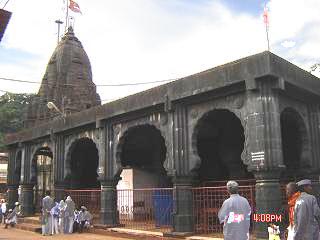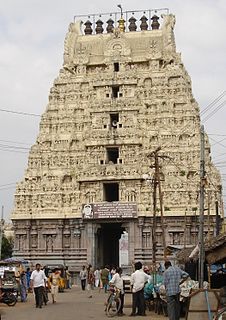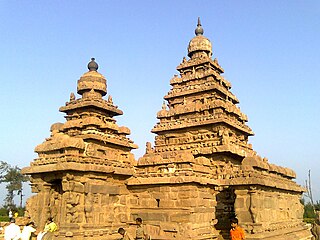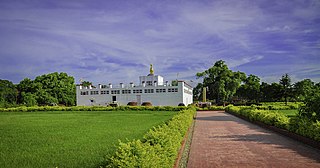Related Research Articles

Shriners International, also commonly known as TheShriners or formerly known as the Ancient Arabic Order of the Nobles of the Mystic Shrine, (AAONMS) is a Masonic society established in 1870 and is headquartered in Tampa, Florida.

A shrine is a holy or sacred site dedicated to a specific deity, ancestor, hero, martyr, saint, daemon, or similar figure of respect, wherein they are venerated or worshipped. Shrines often contain idols, relics, or other such objects associated with the figure being venerated. A shrine at which votive offerings are made is called an altar.

The Ashtalakshmi Kovil is a Hindu temple, which lies on the shorelines near the Elliot's beach, in Chennai, India. The temple is dedicated to the goddess Lakshmi, and her eight primary forms – the Ashtalakshmi – the giver of all eight forms of wealth, namely, offspring, success, prosperity, wealth, courage, bravery, food, and knowledge. The sanctorums are depicted on a multi-tier complex in such a way that visitors could visit all the shrines without stepping over any of the sanctorums.

Bhimashankar Temple is a Jyotirlinga shrine located 50 km Khed taluka, near Pune, in Maharashtra, India. It is located 127 km from Shivajinagar in the Ghat region of the Sahyadri Mountains. Bhīmāshankar is also the source of the river Bhima, which flows southeast and merges with the Krishna river near Raichur. The other Jyotirlinga shrines in Maharashtra are Trimbakeshwar near Nashik and Grishneshwar.

A Shinto shrine is a structure whose main purpose is to house ("enshrine") one or more kami. Its most important building is used for the safekeeping of sacred objects and not for worship. Although only one word ("shrine") is used in English, in Japanese, Shinto shrines may carry any one of many different, non-equivalent names like gongen, -gū, jinja, jingū, mori, myōjin, -sha, taisha, ubusuna or yashiro.

Omamori are Japanese amulets commonly sold at Shinto shrines and Buddhist temples, dedicated to particular Shinto kami as well as Buddhist figures, and are said to provide various forms of luck or protection.

Buddhist temples or Buddhist monasteries together with Shinto shrines, are considered to be amongst the most numerous, famous, and important religious buildings in Japan. The shogunates or leaders of Japan have made it a priority to update and rebuild Buddhist temples since the Momoyama period. The Japanese word for a Buddhist temple is tera (寺) and the same kanji also has the pronunciation ji, so that temple names frequently end in -dera or -ji. Another ending, -in (院), is normally used to refer to minor temples. Such famous temples as Kiyomizu-dera, Enryaku-ji and Kōtoku-in are temples which use the described naming pattern.

The Kamakshi Temple is an ancient Hindu Temple dedicated to Kamakshi, the ultimate form of Goddess Lalitha Maha Tripurasundari. It is located in the historic city of Kanchipuram, near Chennai, India. The Meenakshi Temple in Madurai, the Akilandeswari temple in Thiruvanaikaval near Tiruchirappalli and this Kamakshi temple are the important centers of worship of Goddess, in the state of Tamil Nadu. The Temple was most probably built by the Pallava kings, whose capital was Kanchipuram.

Meenakshi Temple is a historic Hindu temple located on the southern bank of the Vaigai River in the temple city of Madurai, Tamil Nadu, India. It is dedicated to Thirukamakottam udaya aaludaiya nachiyar Meenakshi, a form of Parvati, and her consort, Sundareshwar, a form of Shiva. The temple is at the center of the ancient temple city of Madurai mentioned in the Tamil Sangam literature, with the goddess temple mentioned in 6th century CE texts. This temple is one of the Paadal Petra Sthalam. The Paadal Petra sthalam are 275 temples of lord Shiva that are revered in the verses of Tamil Saiva Nayanars of 6th-9th century CE.

Thiruvarkadu Bhagavathi Temple is the mother temple of all Bhadrakali shrines of North Kerala. The deity is the Fierce form of Bhadrakali. The Bhagavathy is addressed by tantrics in the vicinity as Tiruvarkkad Achchi due to this. The temple administration is Malabar Devaswom Board. The temple is a revered shrine of Chirakkal Royal Family and a shrine of Chirakkal devaswom before. The temple is situated in Madayi, Payangadi, hence prominently known as Madayi Kavu.

An ancestral shrine, hall or temple, also called lineage temple, is a temple dedicated to deified ancestors and progenitors of surname lineages or families in the Chinese tradition. Ancestral temples are closely linked to Confucian philosophy and culture and the emphasis that it places on filial piety.

In Japan, a chinjusha is a Shinto shrine which enshrines a tutelary kami; that is, a patron spirit that protects a given area, village, building or a Buddhist temple. The Imperial Palace has its own tutelary shrine dedicated to the 21 guardian gods of Ise Shrine. Tutelary shrines are usually very small, but there is a range in size, and the great Hiyoshi Taisha for example is Enryaku-ji's tutelary shrine. The tutelary shrine of a temple or the complex the two together form are sometimes called a temple-shrine. If a tutelary shrine is called chinju-dō, it is the tutelary shrine of a Buddhist temple. Even in that case, however, the shrine retains its distinctive architecture.

Until the Meiji period (1868–1912), the jingū-ji were places of worship composed of a Buddhist temple and a Shintō shrine, both dedicated to a local kami. These complexes were born when a temple was erected next to a shrine to help its kami with its karmic problems. At the time, kami were thought to be also subjected to karma, and therefore in need of a salvation only Buddhism could provide. Having first appeared during the Nara period (710–794), jingū-ji remained common for over a millennium until, with few exceptions, they were destroyed in compliance with the Kami and Buddhas Separation Act of 1868. Seiganto-ji is a Tendai temple part of the Kumano Sanzan Shinto shrine complex, and as such can be considered one of the few shrine-temples still extant.

The Shore Temple is so named because it overlooks the shore of the Bay of Bengal. It is located near Chennai in Tamil Nadu.

Maya Devi Temple is an ancient Buddhist temple situated at the UNESCO World Heritage Site of Lumbini, Nepal. It is the main temple at Lumbini, a site traditionally considered the birthplace of Gautama Buddha. The temple stands adjacent to a sacred pool and a sacred garden. The archaeological remains at the site were previously dated to the third-century BCE brick buildings constructed by Ashoka. A sixth-century BCE timber shrine was discovered in 2013.
Kanattampuliyur Pathanchalinathar Temple is a Hindu temple located at Kanattampuliyur in Cuddalore district of Tamil Nadu, India. The historical name of the place is Tirukanattumullur. The presiding deity is Shiva. He is called as Patanjaleeswarar. His consort is known as Kola Valai Kai Ambicai.
Tirupperumpuliyur Vyakrapureeswarar Temple is a Hindu temple located at Perumpuliyur in Thanjavur district of Tamil Nadu, India. The presiding deity is Shiva. He is called as Vyakrapureeswarar. His consort is known as Soundaryanayaki.

The group temples of Jainism are situated on the Mount Girnar situated near Junagadh in Junagadh district, Gujarat, India. There temples are sacred to the Digambara and the Svetambara branches of Jainism.

Sri Govindarajaswamy Temple is an ancient Hindhu-vaishnavite temple situated at the heart of the Tirupati city in Chittoor District of Andhra Pradesh state in India. The temple was built during 12 century and was consecrated in the year 1130 AD by Saint Ramanujacharya. The temple is one of the earliest structures in Tirupati and also one of the biggest temple complex in Chittoor district. The Tirupati(down hill) city is built around this temple. The temple at current is being administered by Tirumala Tirupati Devasthanams.
Atthippuliyur Chidambaresvarar Temple is a Hindu temple dedicated to the deity Shiva, located at Atthippuliyur in the Nagapattinam district, Tamil Nadu, India.
References
| This article about Hindu place of worship in Tamil Nadu is a stub. You can help Wikipedia by expanding it. |
| | This Thanjavur district location article is a stub. You can help Wikipedia by expanding it. |